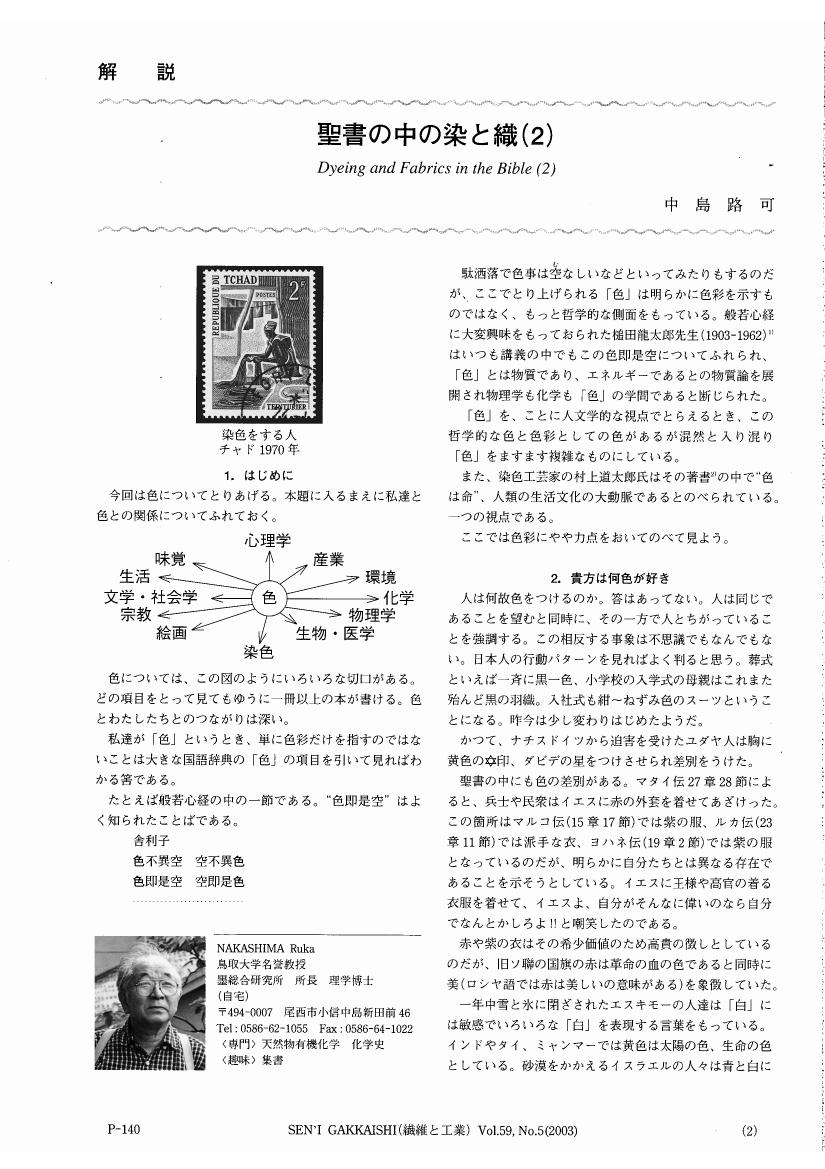1 0 0 0 真実和解委員会と女性 : 南アフリカ文学の役割
- 著者
- 佐竹 純子
- 出版者
- プール学院大学
- 雑誌
- プール学院大学研究紀要 (ISSN:13426028)
- 巻号頁・発行日
- vol.48, pp.165-171, 2008-12
1 0 0 0 OA 聖書の中の染と織(2)
- 著者
- 中島 路可
- 出版者
- 社団法人 繊維学会
- 雑誌
- 繊維学会誌 (ISSN:00379875)
- 巻号頁・発行日
- vol.59, no.5, pp.P_140-P_146, 2003 (Released:2004-08-31)
1 0 0 0 OA 色彩美感情について (三)
- 著者
- 今堀 友市
- 出版者
- 公益社団法人 日本心理学会
- 雑誌
- 心理研究 (ISSN:18841066)
- 巻号頁・発行日
- vol.21, no.123, pp.194-221,227, 1922-03-01 (Released:2010-07-16)
1 0 0 0 OA 黄色い太陽
- 著者
- 西田 秀雄
- 出版者
- 日本美術教育学会
- 雑誌
- 美術教育 (ISSN:13434918)
- 巻号頁・発行日
- vol.1954, no.18, pp.23-25, 1954-04-01 (Released:2011-08-10)
1 0 0 0 OA 紙風船のなぞ解き
- 著者
- 高橋 秀俊
- 出版者
- 東京大学理学部
- 雑誌
- 東京大学 理学部廣報
- 巻号頁・発行日
- vol.6, no.3, pp.7-8, 1974-03-10
- 著者
- カスティジョ ファン ルフィノ 杉本 俊多
- 出版者
- 日本建築学会
- 雑誌
- 日本建築学会計画系論文集 (ISSN:13404210)
- 巻号頁・発行日
- vol.67, no.559, pp.291-298, 2002
本論文はミース・ファン・デル・ローエのフッベ邸(1935年)の設計過程において残されたスケッチを分析することにより、その設計過程の特質を明らかにしようとするものである。設計過程は大きく二段階に分けることができた。第一段階は平面図スケッチを通してのデザインコンセプトの決定過程であり、第二段階は透視図スケッチを通しての空間特性の詳細な決定過程である。平面図スケッチにおいては各空間のレイアウトが検討されており、計6段階に整理できた。そこでは空間構成の大きな変化が認められるが、開放的なレイアウトが次第に外壁の矩形の輪郭に収められていく過程が見出された。また東側面の開口部の配置に着目することにより、東方向への視野がデザイン上、重視されたことが推定された。その東方向の眺望をCAD透視図でシミュレーションすることにより、居間の開放性とプライベートな閉鎖空間が、眺望の微妙なコントロールによって調整されたことが明らかとなった。壁面位置の微妙な調整などの詳細な空間デザインは、ラフな透視図スケッチをいくつか描くことによって、三次元的に、また眺望の検討によって決定されていたことが、試行錯誤を示すスケッチの詳細な分析から確認された。最終段階の透視図スケッチの詳細な分析から、空間構成の枠組みが決定された後、設計助手が定規を用いた線的な透視図を描き、ミースが壁面の素材、家具、庭木や彫刻、また遠景をフリーハンドで描き込み、次第に厳密に決定されていくというプロセスを辿ったことが明らかになった。
- 著者
- 大野 成樹
- 出版者
- 北海道大学スラブ研究センター
- 雑誌
- スラヴ研究 (ISSN:05626579)
- 巻号頁・発行日
- no.47, pp.91-115, 2000
In former studies about Russian banks, analysis from a comprehensive viewpoint has been almost completely ignored. In order to clarify the characteristics of Russian banking activities, an analysis from the viewpoints of bank location, foundation and scale is indispensable. Russian banks have shown some distinguishing characteristics in their activities when viewed by these classifications. To analyze this situation, we have classified Russian banks in this article by their location, foundation and scale. To do this we used the lists of large Russian banks that were periodically published in "Ekonomika i zhizn'" (data as of July 1994, January 1995, January 1996 and January 1997; the list has not been published since 1998) and "Finansovye izvestiia" (data as of January 1996, January 1997 and January 1998). The situation after 1998 was not analyzed because of the lack of information. For an analysis of Russian banking activities by bank foundation, banks were classified into former state banks and non-former state banks. Former state banks include the Savings Bank of Russia, Promstroibank of USSR, Agroprombank of USSR, Zhilsotsbank of USSR (excluding the Foreign Trade Bank of Russia) and the Foreign Trade Bank of Russia. For an analysis of activities by their location, banks were classified into those which were located in Moscow city and Moscow oblast (hereafter referred to as Moscow banks) and those in 11 other economic regions (North, Northwest, Central excluding Moscow city and Moscow oblast, Volga-Vyatka, Central Black-Soil, Volga, North Caucasus, Urals, West Siberia, East Siberia, and Far East; Kaliningrad was excluded because there were no data about it). The banks in these economic regions are referred to below as regional banks. In addition, regression analysis was applied to clarify differences in banking activities by bank foundation and location. Because of the limited data, in the regression banks were classified by foundation into former state banks and non-former state banks, and banks were classified by location into Moscow banks and regional banks. In the analysis by bank scale, data were taken into account for the banks that were ranked as the 50 top banks in the 100 largest bank lists and for 50 banks from the bottom of the lists. Regression was then used to confirm whether or not differences existed in the activities between large banks and medium-sized banks. Before analyzing Russian banks' activities by these classifications, let us survey the trends and changes of their lending and investing activities. Russian banks earned profits under the hyperinflation caused by the liberalization of prices in January 1992, through devaluation of their liabilities and from other sources. Subsequent government tight money policies led to the suppression of inflation and stabilization of the ruble exchange rate. From about 1994, therefore, banks tended to increase loans to other banks, although they still held a large share of hard currency as non-working assets. The banks made profits by raising funds in the call market and lending the money as call loans under a positive yield curve for terms longer than the call money repayment period. Such a profit-making structure collapsed under tight monetary and fiscal policies, however, and some banks fell into default in August 1995. Banks therefore began to place more emphasis on their lending activities to non-bank sectors or to holdings of state securities. Especially after 1995 the amount of outstanding state securities has increased dramatically, because the government was prohibited in 1995 from compensating its budget deficits with Central Bank loans. Because the inflation rate decreased further in 1996-1997, the refinance rate of the Central Bank also was reduced. This resulted in the decline of the yield on state securities. During these years banks tended to increase the amount of loans to non-bank sectors, reducing the proportion of non-working assets. In the following sections we will analyze loans to non-bank sectors, loans to other banks and holdings of state securities. 1. Loans to non-bank sectors. In this section we will analyze the general situation regarding loans to non-bank sectors and the situation of foreign currency-denominated loans to non-bank sectors. (1) General situation of loans to non-bank sectors. First we analyzed the situation by foundation of banks. In the data of "Ekonomika i zhizn'" the share of loans to non-bank sectors in the assets of the former Promstroibank and Agroprombank was high. This was because these banks had strong relationships with their customers, industrial and agricultural companies. In contrast, the share of loans to non-bank sectors in the assets of the former Zhilsotsbank was lower than that of the former Promstroibank and Agroprombank. Banks that originated from the former Zhilsotsbank did not tend to participate in unprofitable government economic programs such as agricultural programs. Activities of these banks were quite different -- some of them gave priority to loans to non-bank sectors, while others gave weight to operations of state securities. The share of loans to non-bank sectors at the Foreign Trade Bank of Russia was much lower than that of banks of other categories. That was because its main activities were to hold its assets in hard currency in foreign banks. The share of loans to non-bank sectors at non-former state banks was lower than that of the former Promstroibank and Agroprombank but higher than that of the former Zhilsotsbank. Let us further analyze the situation of loans to non-bank sectors by the location of banks. In the data of "Ekonomika i zhizn'" the share of loans to non-bank sectors at Moscow banks was much lower than that of regional banks in 1994 and 1995, but in 1996 and 1997 differences between Moscow banks and regional banks became smaller. Furthermore, regression indicates that the share of loans to non-bank sectors at smaller Moscow former state banks tended to be greater in 1994 and 1995. From the viewpoint of the scale of banks, the share of loans to non-bank sectors at larger banks tended to be lower. But in 1996 and 1997 differences between classifications were smaller. In the data of "Finansovye izvestiia" the share of loans to non-bank sectors in the assets of non-former state banks was the highest of all categories by foundation of bank. At the former Promstroibank, Agroprombank and Zhilsotsbank and at the Foreign Trade Bank of Russia, the share was about 20-30%. In the data of "Finansovye izvestiia" the share of loans to non-bank sectors at non-former state banks exceeded that of the former Promstroibank and Agroprombank. This is different from the result of the analysis based on the data of "Ekonomika i zhizn'" and is caused by the difference in the definition of "asset" in the data. This means the share of interest arrears, the inter-office account and other assets in the assets of the former Promstroibank and Agroprombank was larger than the share at non-former-state banks. The share of loans to non-bank sectors at the Savings Bank of Russia was much lower than that of other categories. This was caused by the weakness of the bank's relationship with companies in the Soviet era. In the data of "Finansovye izvestiia" regression shows that larger non-former state banks tended to loan more, whereas differences between Moscow banks and regional banks were weaker. On the other hand, differences between large banks and medium-sized banks became greater as years passed, which is distinguished by the smaller proportion of loans to non-bank sectors at larger banks. (2) Foreign currency loans to non-bank sectors. The data of "Finansovye izvestiia" were used for an analysis of foreign currency loans to non-bank sectors (there were no such data in "Ekonomika i zhizn'"). The data showed that of loans to non-bank sectors, the share of foreign currency loans tended to be larger at the non-former state banks than at the former state banks, but differences by location of banks were weak. Regression shows that the share of foreign currency loans to non-bank sectors denominated at larger non-former state banks tended to be greater. Differences between large banks and medium-sized banks were evident. 2. Loans to other banks. In this paper we defined "loans to other banks" as loans that were included in the category "Loans" on the balance sheet, excluding deposits in correspondent accounts at other banks. Only the data in 1994 and 1995 of "Ekonomika i zhizn'" were consistent with this definition. According to the data the proportion of loans to other banks in the total of all bank loans was high in Central (excluding Moscow city and Moscow oblast) in 1994, and high in Moscow city and Moscow oblast and Urals in 1995. Therefore differences in loans to other banks between Moscow banks and regional banks were not so evident. From the viewpoint of the foundation of banks, the share of loans to other banks at non-former state banks was higher. This was related to the weakness of their relationship with companies when compared with the former Promstroibank and Agroprombank, as well as the lower overall share of loans to non-bank sectors (in the data of "Ekonomika i zhizn'"). Moreover, regression proved that non-former state banks tended to loan to other banks more than former state banks. On the other hand, differences between large banks and medium-sized banks were not observed in the data. 3. Holdings of state securities. Data about holdings of state securities were available in "Finansovye izvestiia." From the viewpoint of the foundation of banks the share of state securities in the assets of the Savings Bank of Russia was far larger than that of other categories, and the share in the assets of the Foreign Trade Bank of Russia was relatively high. Differences between former state banks and non-former state banks were clear. From the viewpoint of location, the share of state securities in the assets of Moscow banks tended to be higher than the share at regional banks. Analysis by regression showed that in 1996 and 1998, differences in holdings of state securities by both foundation and location were clear, and the share of state securities at larger Moscow former state banks tended to be higher. Furthermore, in 1996 and 1998 differences between large banks and medium-sized banks were clear, judged from the higher share of state securities in the assets of large banks than those of medium-sized banks. Conclusion. In many phases of Russian banking activities, differences in characteristics according to the foundation of banks came to the fore. Differences in characteristics by the location of banks were weaker, except for holdings of state securities. Differences based on the scale of banks were outstanding, especially differences in loans to non-bank sectors. Recently differences in the activities between large banks and medium-sized banks have attracted more media attention. On the other hand, differences by foundation of banks in particular have tended to be ignored. Our analysis indicates, however, that viewing bank activity from the standpoint of the foundation of banks is still effective to explain Russian banking activities. Our work may as well be the first step towards understanding the changing activities of Russian banks since the collapse of USSR. The task of analyzing the situation after the crisis of August 1998 remains to be addressed.
1 0 0 0 OA 超越論的哲学とパースペクティヴ主義についての批判的研究ー近現代哲学の帰趨ー
- 著者
- 安江 政一 加藤 義成 林 玉美 榊原 仁作
- 出版者
- 公益社団法人日本薬学会
- 雑誌
- 藥學雜誌 (ISSN:00316903)
- 巻号頁・発行日
- vol.88, no.6, pp.738-741, 1968-06-25
- 被引用文献数
- 1
Dried leaves of Acanthopanax sciadophylloides FRANCH. et SAV. were extracted with methanol and the water-soluble part of the extract was treated successively with solutions of lead acetate, basic lead acetate, and ammoniacal alkaline lead salt, as shown in Chart 1. myo-inositol, scyllitol, kaempferitrin, and antoside were isolated and identified. The constituents of these leaves were somewhat different according to the district where the materials came from. Utkin had suggested the structure of antoside as quercetin 3 (7)-glucosido-7 (3)-rhamnoside. Relative positions of glucose and rhamnose in the antoside molecule were now determined by enzymatic cleavage of rhamnose to give quercetin 3-glucoside (isoquercitrin) (Chart 2).
1 0 0 0 OA コシアブラ抗酸化成分の促成栽培条件による変動(栽培管理・作型)
- 著者
- 村山 徹 箭田 浩士 宮沢 佳恵
- 出版者
- 園芸学会
- 雑誌
- 園芸学研究 (ISSN:13472658)
- 巻号頁・発行日
- vol.6, no.2, pp.241-245, 2007-04-15
- 被引用文献数
- 1 2
コシアブラ若芽の抗酸化活性をβ-カロテン退色法とDPPHラジカル消去活性で評価したところ,高い活性を示した.主たる抗酸化成分は,クロロゲン酸と同定された.グロースチャンバー試験で,その成分含量に影響する要因を検討したところ,光が強く,穂木が良いと含量が高まることが示された.その結果に基づいて,好適な促成栽培技術を確立するため,ガラス室内で栽培条件が収量と抗酸化成分含量に及ぼす影響を検討した.促成栽培では, 10〜15℃の木に30〜40cmの穂木を挿すことによって,クロロゲン酸含量の多い若芽を収穫できた.
1 0 0 0 OA コシアブラの葉の成分に関する研究
- 著者
- 北島 潤一 高森 靖 田中 靖子
- 出版者
- 公益社団法人日本薬学会
- 雑誌
- 藥學雜誌 (ISSN:00316903)
- 巻号頁・発行日
- vol.109, no.3, pp.188-191, 1989-03-25
- 被引用文献数
- 1
In fresh leaves of Acanthopanax sciadophylloides FR. et SAV. collected in June, the following substances were identified : (-)-β-caryophyllene, trans-β-farnesene, phytol, 1-dotriacontanol, taraxerol, a mixture of stigmasterol and β-sitosterol, trans-p-coumaric acid, trans-p-coumaric acid methylester, afzerin, kaemferitrin, kaempferol 7-O-α-L-rhamnopyranoside, 3-O-β-D-galactopyranosyl kaempferol 7-O-α-L-rhamnopyranoside and quercetin 3,7-O-bis-α-L-rhamnopyranoside. On the other hand, from the fresh leaves collected in August, trans-p-coumaric acid and kaempferol were obtained as aromatic compounds, but flavonoid glycosides were not detected. It is interesting that the constituents of these leaves were quite different between June and August.
- 著者
- 木前 利秋
- 出版者
- 日本社会学会
- 雑誌
- 社会学評論 (ISSN:00215414)
- 巻号頁・発行日
- vol.53, no.3, pp.437-438, 2002-12-31
1 0 0 0 OA 胎生期低亜鉛環境が引き起こす仔におけるエピゲノム変化の解析
- 著者
- 栗田 尚佳
- 出版者
- 東京大学大学院医学系研究科社会医学専攻
- 巻号頁・発行日
- 2011-03-24
報告番号: 甲27030 ; 学位授与年月日: 2011-03-24 ; 学位の種別: 課程博士 ; 学位の種類: 博士(医学) ; 学位記番号: 博医第3640号 ; 研究科・専攻: 医学系研究科社会医学専攻
平成13年度〜平成15年度の研究実績は以下の通りである。中国農村実態調査は毎年夏、計3回実施し、初年度は上海市奉賢区Q鎮T村、2年目は上海市南匯区D鎮C村と上海市奉賢区Q鎮B村、上海市宝山区Y鎮S村、3年目は上海市松江区X鎮C村と松江区C鎮X村で、村幹部から村経済概況をインダビューし、農家を訪問して直接農民から聞き取り調査を行い、農家アンケート調査を実施した。さらに、比較研究の視点から内陸の成都市近郊農村、青島市近郊農村や杭州市近郊農村でも実態調査を行った。また、農村の工業化と都市化の進展が著しい江蘇省昆山市・蘇州市・呉江市、上海市区の松江区といった長江デルタでの労働力移動の分析を行うため、工業開発区や輸出加工区での聞き取り調査を実施した。特に、こられの工業開発区や輸出加工区に投資する外資系企業を訪問して、労働力の流動を中心に就業者の出身地や雇用条件などについてインタビューを行った。また、長江デルタと珠江デルタの農村開発を比較するために、珠江デルタの深〓市や東莞市などの日系企業と台湾系企業を訪問し、これら企業に就労する内陸農村からの出稼ぎ労働力についてインタビューを行った。これらの調査研究に基づいて、計19回の定例研究会を実施し、そのうち4回の研究合宿と2回の公開シンポジウムを開催した。それぞれの公開シンポジウムでは上海財経済大学の研究者3名と重慶社会科学院経済研究所の研究者3名を招聘して研究報告と討論を行った。これらの研究成果は論文として発表されているが、私たちの共同事業として平成14年度には研究成果中間報告書(全161ページ)を、平成15年度には研究成果報告書(全228ページ)を作成した。研究成果報告書はさらに検討を加え、出版助成金を得て公開する予定である。
1 0 0 0 「千と千尋の神隠し」における水、まなざし、トラウマ
- 著者
- 太田 裕一
- 出版者
- 静岡大学
- 雑誌
- 静岡大学心理臨床研究
- 巻号頁・発行日
- vol.6, pp.3-10, 2007
1 0 0 0 OA フライングディスクの展開 : アルティメットに特化した授業の構築(私の授業ノート2)
- 著者
- 長澤 純一
- 出版者
- 社団法人全国大学体育連合
- 雑誌
- 大学体育 (ISSN:02892154)
- 巻号頁・発行日
- vol.33, no.2, pp.52-57, 2006-12-15
- 著者
- 山内祐平編著 林一雅 [ほか] 執筆
- 出版者
- ボイックス
- 巻号頁・発行日
- 2010
1 0 0 0 OA シモーヌ・ヴェイユの労働観 : 工場体験と新たな方向
- 著者
- 宮川 文子 ミヤガワ フミコ Miyagawa Fumiko
- 出版者
- 大阪大学フランス語フランス文学会
- 雑誌
- Gallia (ISSN:03874486)
- 巻号頁・発行日
- vol.25, pp.53-61, 1986-03-31
- 著者
- 太田 裕一
- 出版者
- 静岡大学
- 雑誌
- 静岡大学心理臨床研究
- 巻号頁・発行日
- vol.8, pp.67-74, 2009








